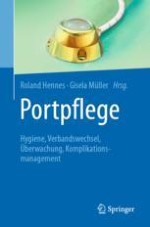Erschienen in:
2020 | OriginalPaper | Buchkapitel
5. Expertenstandard Portpflege
Zusammenfassung
Da es in der Bundesrepublik Deutschland bislang keine einheitliche Leitlinie zur Versorgung von Patienten mit zentralvenösen Portsystemen gibt, basieren die im Folgenden formulierten Empfehlungen auf Richtlinien des Robert Koch-Institutes und auf der langjährigen Expertise des Universitätsklinikums Heidelberg. Die standardisierte fachliche Pflege von implantierten Portsystemen ist nach der Portimplantation die wichtigste Maßnahme, um für die Patienten einen dauerhaften, komplikationsfreien und sicheren Zugang zu gewährleisten. Anhand einer Studie des Universitätsklinikums Heidelberg, in der bei 385 Patienten die Gründe einer Portexplantation untersucht wurden, konnte eindeutig gezeigt werden, dass die Portinfektion die häufigste Komplikation bei implantierten Portsystemen darstellte und häufig zur Explantation der Systeme führte.
Anzeige















